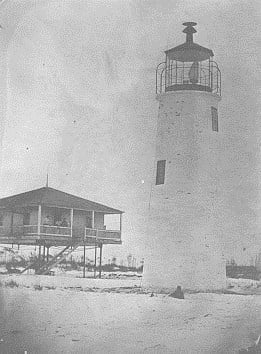Dog Island Lighthouse-Replaced by Crooked River

The Dog Island Lighthouse was the first lighthouse, a 50-foot brick tower and was completed in 1839. A storm in 1842 destroyed the keeper's house and badly damaged the lighthouse tower. A 40-foot wooden tower was completed in 1843 to replace the brick tower. This second tower was destroyed by a hurricane in 1851. A 40-foot brick tower was built in 1851. This is the lighthouse in the photo. The obsolete lamp and reflector system in the light was replaced by a Forward drop lens in 1856, which was more efficient.
During the Civil War, Confederate forces burned the stairs in the tower and damaged the lens to prevent the tower from being used as a lighthouse or a watchtower. The light was repaired and put back into service after the war. In 1872 beach erosion undermined the tower and caused it to fall. The lantern was salvaged and was moved to the top of the keeper's dwelling. On September 18, 1873 a hurricane destroyed both the tower and the keeper's dwelling.
Congress appropriated funds for a replacement in 1874, but the Lighthouse Board stated, "This light can only serve a local commerce, of which, for several years, there has been little or none; and it is therefore recommended that the new work be indefinitely postponed." The Dog Island Light was never replaced. The Crooked River Light (built near Carrabelle on the mainland in 1895) serves as a leading light for the same channel that was formerly marked by the Dog Island Light.
In 1999, a team of maritime archaeologists led by Chuck Meide, as part of Florida State University's Dog Island Shipwreck Survey, acoustic and electromagnetic devices, side-scan sonar and magnetometer were used to search the waters off Dog Island. Project archaeologists conducted excavations on the wreck of the 1899 Norwegian lumber ship Vale, and also located a number of other submerged archaeological sites, including the ruins of the Dog Island Lighthouse. The submerged brick ruins are now located on the offshore side of the island, as the island itself is slowly migrating towards land and has passed completely over the lighthouse's original position inside the island. The site was re-investigated by Florida State University archaeologists as part of a 2006 summer field school, and various features of the lighthouse—including remains of the keeper's house, were found.
Categories: History

